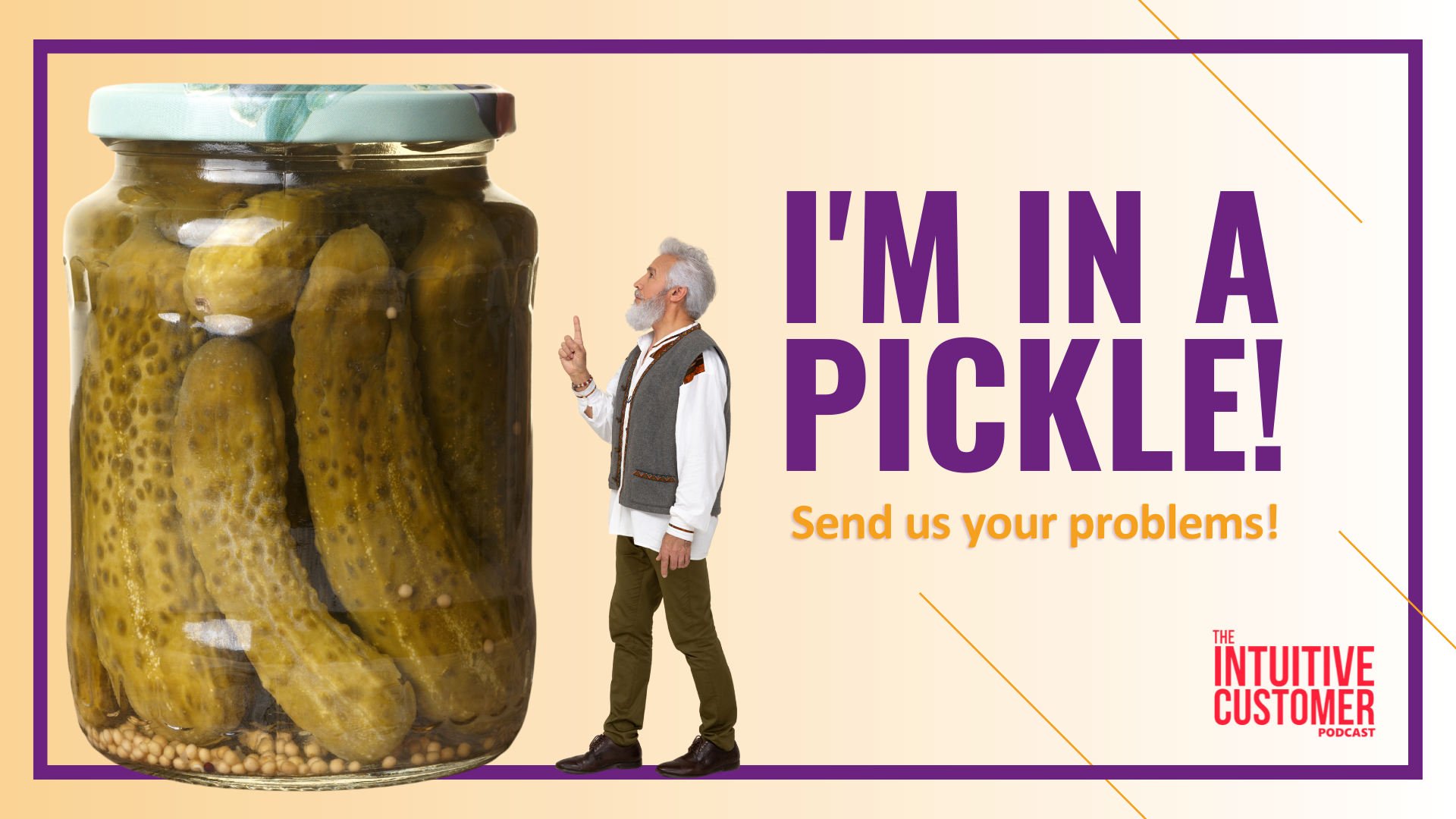There is a saying that says, “Imitation is the highest form of flattery,” and it is. However, it is also a losing strategy when you are working at winning over customers from the competition. Finding a way to stand out is the secret to long-term customer strategy success.
Fernando deals with this problem in his business branding and packaging for fast-moving consumer goods and consumer packaged goods (CPG). His clients often want to copy the competition and follow their lead. However, Fernando wanted to distinguish his clients from the competition. We discussed this challenge on a recent podcast; I thought we could cover it here too for those of you with a similar problem.
Humans are social creatures. From an evolutionary perspective, we are social because we need to be accepted by the pack to increase our chance of survival. Now, we do it to fit in.
 From a business perspective, our need to “fit in” has different motivations, which the behavioral sciences can explain. We are naturally risk averse, particularly regarding business and financial security. Making a high-stakes decision and getting it wrong can have catastrophic effects for both business and personal bottom lines. It’s part of Loss Aversion, which is the idea that losing things feels worse than gaining things feels good. So, we tend to follow the pack and enjoy some of the success the competition has cultivated. This example also demonstrates the idea of Social Proof, which tells us that if it is working for this group, then it will probably work for us, too.
From a business perspective, our need to “fit in” has different motivations, which the behavioral sciences can explain. We are naturally risk averse, particularly regarding business and financial security. Making a high-stakes decision and getting it wrong can have catastrophic effects for both business and personal bottom lines. It’s part of Loss Aversion, which is the idea that losing things feels worse than gaining things feels good. So, we tend to follow the pack and enjoy some of the success the competition has cultivated. This example also demonstrates the idea of Social Proof, which tells us that if it is working for this group, then it will probably work for us, too.
However, this customer strategy is not great. To quote the late, great Carrie Fisher as Princess Leia, “It’s a trap!” If you fall into the thinking that the only way to succeed is to defeat competitors, then you are likely overlooking an excellent opportunity. So, instead of doing what they do, we recommend building a customer strategy around improving what the competition does. Not only might this approach win over some of the current markets, but it might also uncover a whole new customer market that has never been served in this space.
Identifying your place in the market is essential to growth and ultimate victory over the competition. When you can find customers you understand better and deliver value to, you realize more success than being as good as the competition and targeting the same group of people.
To get started on this customer strategy, you must first answer the following about your market:
- How does distinctiveness matter?
- How do customers value distinctiveness?
- How do businesses value distinctiveness?
Because of risk aversion, the default from a business standpoint is to adopt a best-practices approach. After all, those have already proven to be successful. However, best practices as a customer strategy are inherently reductive. If everybody does it, everyone’s competition in the space is the same. Moreover, we interviewed Vice Chairman of Ogilvy UK Rory Sutherland, who says the only way to compete for the long-term is not to do what everyone else is doing. Instead, you have to make yourself distinctive.
The Art of Optimal Distinctiveness
It’s here that we create tension for ourselves. We want to be part of the group and confirm because to do otherwise is risky. However, we also want to stand out from the crowd. Both are valid feelings and can exist within us at the same time. This resulting tension drives a lot of our behavior, both as business leaders and as customers.

Let me give you an example of what I mean about having both feelings simultaneously from a customer perspective. I bought a car recently, and I chose a black package on the grille. However, it is a pretty standard car on the road, and my wife Lorraine asked me why I didn’t get the model with the silver grille that she saw everywhere. My answer was automatic, “because the black is different.” Now, I could have bought a different car than everyone else, something rare or unusual, but I didn’t want to be that different. So, the black grille was my expression of individuality in the fleet of similar vehicles.
Psychologists describe my behavior with a theory called Optimal Distinctiveness. It explains that we all behave like this to a degree. If you picture a continuum, on one extreme, there is the true conformist that does not distinguish themselves at all, and then, on the other extreme, there are the non-conformist that bucks the “norm” at every turn. Neither extreme is very attractive to most of us, so we try to balance the two.
Remember high school and the weird cliques. (The beginning of most teen movies will spell them out for you if you don’t.) The Goths. The Jocks. The Nerds. The Metalheads. Each of these cliques is distinct, but the individuals inside the group were very similar. So, for example, you wouldn’t see a Goth that didn’t have some version of black outfit and silver necklaces or a Metal Head wearing a tie—unless it was a headband. The groups had rules about how they were supposed to dress within that small society, and they tended to adhere to that.
All of us do this to a greater or lesser extent. So, if we’re in a group that conforms, we’re part of that tribe. But within that tribe, the members will distinguish themselves. For example, Antiques Roadshow is a TV show where people bring in old heirlooms and have appraisers tell them the value. The appraisers dress in outlandish ways, from eccentric bow ties to plaid three-piece suits to curly waxed mustaches. Sure, it could be because they are on TV, but it might also be a form of Optimal Distinctiveness—just like the girl in sixth period English that wore black lipstick every day of her Freshman year.
Back to Fernando’s Problem…
It sounds like many of Fernando’s clients struggle with the balance between distinctiveness and conformity. Unwritten rules exist about what is appropriate for that CPG category. For example, breakfast cereal is usually in a box that is the same shape and size as the others. It’s not a rule per se, but it is an unwritten and generally understood way that cereal boxes “should be” designed that helps to define the category and helps cereal customers understand what’s there. However, the danger of too much conformity is that it makes the options indistinguishable from each other. So, what if you had a cereal box that was hexagon-shaped? It’s still a box that can stack on the shelf, but now the shape might distinguish it from the others.
This non-conforming shape concept is how we got the term “top shelf” liquor. Many years ago, some distilleries began making their bottles too tall to fit on standard bar shelves. The bartenders then put them on the top, making them visually distinctive. Then, since it was easier to see and grab, customers would ask for it by name. Later, being “top shelf” became a signal of quality liquor, hence the term’s meaning as we know it.
I don’t know if a hexagon cereal box could have the same effect, but maybe. It certainly would change the appearance of the cereal aisle and direct the customers’ eyes.
Another vital area to consider in addition to the shape of the packaging is the target audience’s characteristics. It is essential to understand what drives customer behavior. These values are opportunities for brands to target with their customer strategy. Consider the subconscious signals your products send that might cause people to choose them. Are there ways to use that in a new way for your brand? In other words, creating value for a group of customers should drive your decisions, including design decisions.
So, What Should We Do with This Information?
Fernando’s problem is interesting. He should encourage his clients to think differently about their strategy. Therefore, I say begin by determining what drives the customers’ decision. All the decisions you make to distinguish yourself should link to what your customers want. If they don’t, then start over there.
 Next, remember the concept of optimal distinctiveness that brands can have. As we define the unwritten rules of the category, then also look for areas for distinction opportunities. So, yes, there are areas that you should be the same as the competition. However, that is not what sells you. Differentiation is what drives customers to choose you over the competition. From product design to branding message to delivery systems, several areas present opportunities for experience enhancement for competitive advantage.
Next, remember the concept of optimal distinctiveness that brands can have. As we define the unwritten rules of the category, then also look for areas for distinction opportunities. So, yes, there are areas that you should be the same as the competition. However, that is not what sells you. Differentiation is what drives customers to choose you over the competition. From product design to branding message to delivery systems, several areas present opportunities for experience enhancement for competitive advantage.
Furthermore, it would be best for Fernando to recognize Risk Aversion when he sees it. To overcome it, he should try something small, test it, and then show the results. Changing everything is too big a battle to start with; instead, try a trial in a store or change a section of the experience. It would help to see some small successes before taking on an extensive overhaul of the entire brand.
Education is essential, too. In our global Customer Experience consultancy, we often start by educating the organization on the aspects of a Customer Experience, from the rational stuff they are used to managing to the emotional, subconscious, and psychological parts they are not. Then, we bring them along to our way of thinking. So, Fernando might need to do the same with some subtle nudging. For example, having them listen to a podcast might help (and have I got one for you!). Maybe it’s an article you read or a case study that demonstrated success with various customer strategies you want to employ. By educating your client on why you want to do what you want, you might get them to agree and support the efforts more than if you didn’t bother with it. Some of the questions we ask are “what drives value for your customers,” or “what experience are you trying to deliver?”
Furthermore, as I often say, if you don’t know the answers to those questions, find them out. Research can show you what drives your customer behavior. Knowing what customers value, not just what they say they value, is essential to building a successful customer strategy.
Hopefully, by undertaking these steps, Fernando can persuade his clients to be optimally distinctive. I also hope that this discussion and related advice is helpful to you, too.
If you have a business problem that you would like some help with, contact me on LinkedIn or write to us at www.beyondphilosophy.com/pickle. We would be glad to hear from you and help you with your challenges.
 There you have it. No promotions, no gimmicks, just good information.
There you have it. No promotions, no gimmicks, just good information.
Think reading is for chumps? Try my podcast, The Intuitive Customer instead. We explore the many reasons why customers do what they do—and what you should do about it. Subscribe today right here.


